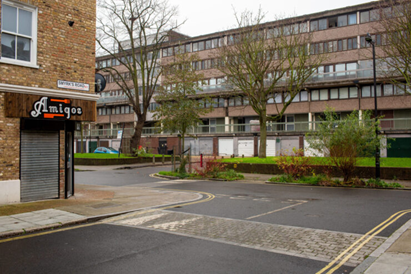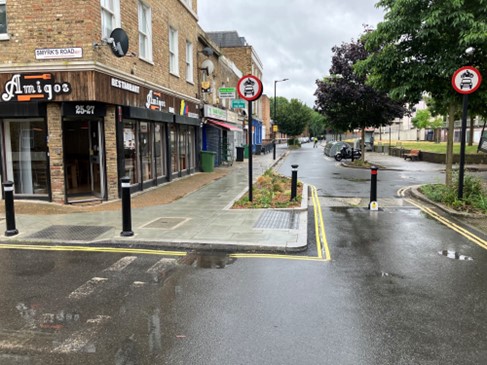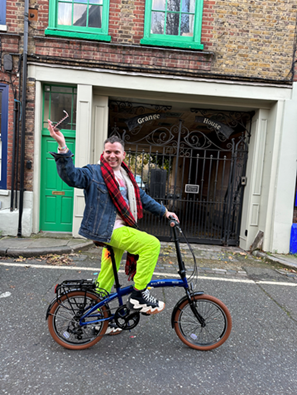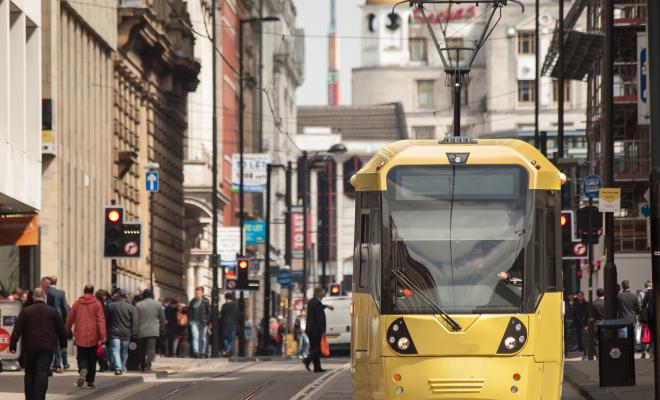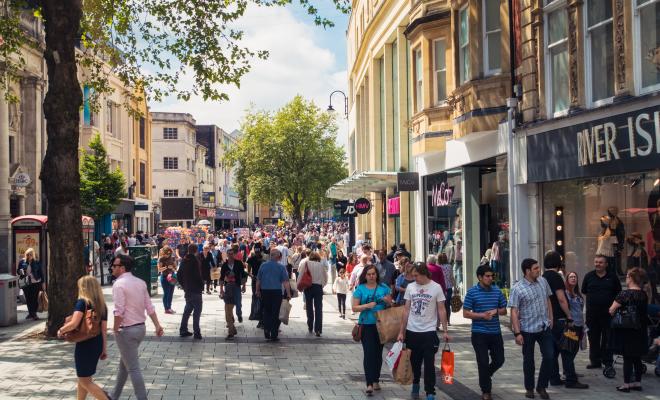20 Sep 2024
How is Action 23 tackling the climate crisis?
In July 2023 Southwark Council launched a major expansion of its active travel work under a new strategy, Streets for People. The strategy includes 71 detailed commitments across 4 themes:
- Streets for Communities: reclaiming space for communities to connect, socialise and play.
- Streets for Journeys: making sustainable travel the easiest option.
- Streets for the Economy: making high streets pleasant places people want to spend time in.
- Streets for Nature: increasing biodiversity, and making streets greener and more resilient to adverse weather.
Guided by these themes, by 2030 Southwark hopes to:
- Reduce the proportion of journeys made by car from 21% to 13%.
- Reduce the number of vehicles owned by 10%.
- Deliver 9 new Streetspace schemes.
- See 87% of all journeys undertaken by walking, wheeling, cycling or public transport.
- Deliver free cycling training for a minimum of 3,000 adults and children annually.
Streets for People replaces the council’s previous 2019 Movement Plan and builds on earlier work promoting the benefits of active travel for health. Under its Movement Plan, which was part-funded by Guy’s and St Thomas’ Foundation (now Impact on Urban Health), the council sought to tackle air quality and reduce obesity. Several pilot Streetspace schemes (areas with measures to cut car use and boost walking and cycling) were implemented in neighbourhoods that ranked poorly on the Mayor of London’s Healthy Streets indicators. These areas were typically low-income, with poor air quality and above-average levels of childhood obesity.
The lessons learned under the Movement Plan laid a strong foundation for the wide-ranging street improvements and active travel schemes now taking place under Streets for People. Although Streets for People is the top-level strategy for the council’s Transport department, it also helps deliver on the council’s climate commitments.
“We have to improve the air we breathe in Southwark and take steps to tackle the climate emergency, as set out in our new Streets for People strategy. There’s so much great work going on. We're creating more opportunities to walk and cycle, improving walking and cycling routes to schools, and investing in our community spaces making them safer, greener and more pleasant environments.”
Councillor James McCash, Cabinet Member for Climate Emergency, Clean Air and Streets
What impact has this had?
Impact from the Movement Plan
Under the Movement Plan, a range of changes were made: new traffic filters, temporary footway widening, improved crossings, 140 new pedestrian crossings, extra on-street seats and benches, and improved cycling accessibility. It should be noted that some of these changes, for example footway widening, were necessary as part of the council’s COVID-19 response, so that social distancing measures could be enacted in public spaces.
Healthy Streets, a global organisation dedicated to embedding public health into transport projects, monitored the pilot Streetspaces in Southwark, with an evaluation published in May 2023. The evaluation looked at 3 Streetspace neighbourhoods versus a control neighbourhood with no changes.
The results in Southwark showed some key successes:
- Traffic volumes decreased in 2 of the Streetspace neighbourhoods
- Traffic speeds decreased in all 3 Streetspace neighbourhoods.
The Streetspace streets evaluated were therefore clearly safer for those who were already walking. However, the evaluation also found that there was no significant increase in active travel, which suggests that people’s physical environment is only one factor determining their mode of travel, and that behavioural change takes a longer time to embed. A greater focus on direct engagement with residents about their needs and interests has been incorporated into Streets for People to address this.
All 10 original Streetspace schemes in Southwark that were introduced prior to Streets for People have been made permanent. Southwark continues to aspire and work towards achieving the Healthy Streets standard. Read the full Healthy Streets evaluation.
Impact from Streets for People
The ambitious Streets for People programme is already demonstrating early signs of impact:
- The number of School Streets, which are initiatives that reduce congestion, traffic and pollution around schools at key times, has increased to 29 borough-wide.
- By April 2024 the new Joyriders scheme saw 2,700 people participate in cycling training.
- Over 3,000 people have downloaded the new BetterPoints app, which “pays” residents to walk, cycle or take public transport by rewarding them with points that can be spent at local businesses or donated to charity.
- A new sharing scheme was launched, allowing businesses, community groups and individuals to hire out a new fleet of electric cargo bikes.
- The council dispensed grants of up to £2,500 for residents to organise street parties or “play street” events to celebrate World Car Free Day.
- 25 new pedestrian crossings were installed by April 2024, adding to the 140 crossings installed over the previous 5 years, with even more planned to make walking across the borough easier and safer.
What made this work?
Political will
A significant amount of political will is required for projects like these. Throughout public consultation processes and as road spaces are redesignated, private vehicle owners are highly likely to object. In Southwark, there was a clear political will from cabinet members to rise above this and carry out risk assessments while continuing to engage communities on the significant and wide-ranging benefits that these road changes create.
Community engagement
Community engagement has been an essential part of this project. The council has used the online tool Commonplace, as well as more traditional methods such as surveys, letters to residents, school engagement and working with local community groups.
Additionally, as part of the Movement Plan the council and Healthy Streets included a group of community researchers to engage with residents of different ages, genders and ethnicities to understand local opinions on the newly implemented measures.
The use of community researchers allows for a fairer indication of local responses. Residents who may normally be hesitant in sharing their views on a local authority-led project are more likely to voice their opinions to a fellow community member.
Initial indications from residents regarding the council’s actions on active travel were mixed but showed that many were in support of the measures. Others were concerned about whether this should be the council’s priority. It’s important to consider that a mixed response was very likely and that it was still important for the council to hear residents' views. The researchers found that people appreciated being able to talk to someone rather than only have the option to submit views online.
“In the early stages of the project the community researchers found that most of the residents they spoke to didn’t know why the changes had happened or how long they would be in place for. This shows why it’s important for councils to communicate with residents: not just to gather feedback about changes but to inform residents before changes are made and to communicate to residents about how and why streets are being changed.”
Dr Niamh McGarry, ClearView Research
Taking this feedback on board under Streets for People, Southwark not only consulted with residents before the strategy was published, but also conducted a borough-wide engagement exercise which concluded in March 2024. This included going door-knocking in communities, events, an online survey and working with partners to spread the message. This was the largest engagement exercise Southwark Council has ever run, with over 9,000 people participating.
Residents were asked what changes they'd like to see in their neighbourhoods, such as more trees, green spaces, cycle hangars, seating, and more spaces to play and socialise in. The feedback will be used to create a street-by-street implementation plan for Streets for People. The responses are already guiding allocation of cycle hangars, improved junctions and share-use paths, and will inform decisions in departments across the council (including Highways, Housing, Parks and Planning) over the next 7 years.
Southwark is also continuing to experiment with interactive engagement. In July 2023 the council put out a call for community influencers, 21 beginners who'd join a 12-month scheme to take up cycling and eventually become cycling ambassadors for their communities. The influencers all received a bike, lights, locks and helmet, as well as training, maintenance and insurance, and all for free.
Here’s what some of the influencers had to say:
“As a computer engineer, I spend most of the day sitting in front of a computer. The pandemic helped me realise how important it is to be fit and healthy, mentally and physically. I’m really enjoying learning to cycle – it’s helping me improve my lifestyle and reduce my carbon footprint. We all deserve a healthy way of life and a greener and cleaner borough!”
Spyros (pictured)
“When I was much younger, I used to love biking around my local area with my friends, but I have been a little frightened about biking in London. I would really like to overcome this barrier through the support of a trained instructor. You feel better, you feel like you can do more things, just like you do with any form of exercise, it’s that hit you get of endorphins. Health benefits 100%, you feel lighter, happier, more active I think.”
Hamieda
“I work in the disability sports sector with young people. I have a physical disability, so I am looking for advice on making a bike more accessible and safer for me to use. Learning how to do ongoing maintenance and repairs would also save me money in the long term.”
Kenneth
Closely involving stakeholders
As well as reaching out to members of the public who have concerns about the proposed measures, it’s important to be in regular dialogue with civil society groups and individuals who are already active on the issue. Southwark Council previously met with its Cycling Stakeholder Group every 2 months and chaired the Walking Joint Steering Group every quarter. The 2 groups have now merged into a single Active Travel Panel. Organisations that attend include London Cycling Campaign, Wheels for Wellbeing, Twenty is Plenty, Living Streets, pensioner groups and disabled activist groups. Through these meetings, local people with expert knowledge can feed directly into the council’s plans.
What resources were needed?
Through Streets for People, the council has committed £12 million in funding to reduce car use and encourage active travel up to 2030.
Streets for People has seen a greater emphasis on dynamic communications and engagement from the council, with dedicated staff time behind this. This has included a paid social media campaign which reached 65,000 people in the first 6 months after Streets for People launched.
Some of the improvements in the Movement Plan were funded by a £250,000 grant from the Guy’s and St Thomas’ Foundation (now Impact on Urban Health), designed to create the maximum public health benefit at the lowest possible cost. As well as covering the installation and development of several active travel measures, this funding covered impact evaluations and reporting. The funding also paid for an officer at the council to progress the scheme, as well as for consultation work within the community. Other councils may want to explore whether their local NHS trusts have similar associated charitable foundations that give out grants.
Lessons from Southwark
Expect and listen to objections
When introducing Streetspace schemes, it's important to expect potential public resistance and to be prepared to change some aspects of the plans as a result. However, councils shouldn’t let this be a barrier overall to implementing crucial measures. The majority of Southwark residents support cutting car use. For example, the 2022 Streets for People consultation showed that 70% of respondents wanted to see less traffic in the borough. It's essential to get wide buy-in for these measures across the area to withstand and counter objections, even if they represent a minority opinion.
In Southwark and elsewhere, effective and early community engagement has been shown to be vital. Co-design can help to overcome objections. The council has learned that a good way of engaging with residents is to meet them and discuss their concerns at the actual sites of the Streetspace schemes. This allows for a proper explanation of the measures, bringing to life the real benefits they bring, such as improvements to health and the local economy.
For instance, the Dulwich Village Streetspace scheme was introduced in 2020, a review was conducted in 2021, and it was made permanent in 2022. Residents repeatedly objected to banning vehicle access along Turney Road. The council accepted this and developed new plans that retained unimpeded access at Turney Road. The plan also includes creating a new community space for Dulwich Village, which the council hopes will become the template for what a Streets for People scheme can be.
“The sky did not fall in. There were noticeably fewer cars, and it made the area safer to walk around. With a toddler and living in these areas, I am conscious of air quality and safety. In my experience, it made the area much nicer, as the roads were emptier.”
Resident in Camberwell, Southwark, where a controlled parking zone was introduced in 2018
Take a joined-up approach
Ultimately there’s only so much progress individual boroughs can make alone. Issues like through traffic and the connectivity of active travel routes are cross-boundary issues. Raising a collective voice alongside other councils to lobby the Mayor of London for wider-ranging changes will ensure Southwark’s efforts aren’t isolated.
Consider the social justice benefits
Encouraging active travel and improving public transport is a method for tackling inequality on a number of levels. Southwark is one of the most densely populated parts of the country, and space is very limited. 75% of residents live in flats or maisonettes, few of which have communal or private garden spaces. Reclaiming streets and making them people-centric instead of car-centric can therefore improve public and personal wellbeing. This is particularly salient given the fact that 42% of people living in inner London experience high levels of anxiety. 70% of residents who responded to the Streets for People consultation were worried about the impact of poor air quality on their health and agreed that greenery is essential to their wellbeing.
Furthermore, 60% of Southwark households don't have access to a car. It’s also true that across London vulnerable groups have less access to cars. For example, 57% of disabled residents, 66% of children, 65% of elderly people and 65% of people of colour in London are reliant on public buses. Southwark itself has the second highest bus usage rate among London boroughs. It’s imperative that active travel and public transport options are convenient and widespread in order to ensure equal access to mobility.
“Our built environment, the way we use our public space, and travel opportunities also impact on social isolation: deprived areas often lack safe, good quality, green community spaces, creating barriers to social engagement. Access to transport is also vitally important in building and maintaining social connections.”
Streets for People strategy
Friends of the Earth's view
Cutting car traffic is essential for reducing climate emissions and creating healthier and safer places to live.
Southwark’s initial partnership with Guy’s and St Thomas’ Foundation ensured a focus on delivering health benefits and targeting measures to locations that will benefit vulnerable communities. This focus on the benefits to residents has continued to be at the forefront of the council’s ambitious Streets for People scheme.
There are important lessons here for community engagement on controversial issues. Lessons learned about how to proactively engage with residents and act on their responses, as well as some innovative ideas around using community champions, will have importance beyond this borough.
Councils should also encourage a shift of remaining car use to electric vehicles to further cut emissions (Actions 20, 24 and 25).
Friends of the Earth is showcasing specific examples of good practice in tackling climate change, but that doesn’t mean we endorse everything that council is doing.
This case study was produced by Ashden and Friends of the Earth. It was originally published in May 2022 and was last updated in July 2024. Any references to national policy in this case study relate to policy under the previous government and reflect the policy context in which the council was operating at the time.



